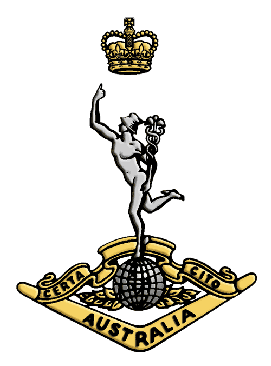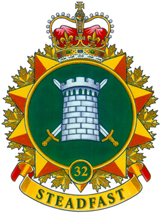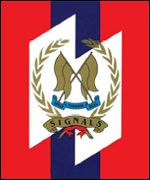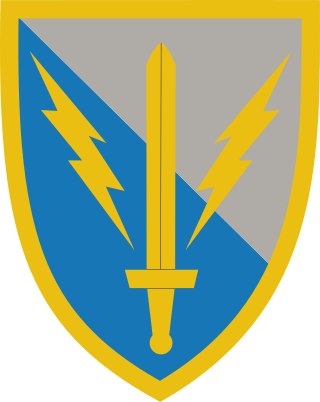Related Research Articles

The Canadian Army is the command responsible for the operational readiness of the conventional ground forces of the Canadian Armed Forces. It maintains regular forces units at bases across Canada, and is also responsible for the Army Reserve, the largest component of the Primary Reserve. The Army is headed by the Commander of the Canadian Army and Chief of the Army Staff, who is subordinate to the Chief of the Defence Staff. The Army is also supported by 3,000 civilian employees from the public service.

The Royal Corps of Signals is one of the combat support arms of the British Army. Signals units are among the first into action, providing the battlefield communications and information systems essential to all operations. Royal Signals units provide the full telecommunications infrastructure for the Army wherever they operate in the world. The Corps has its own engineers, logistics experts and systems operators to run radio and area networks in the field. It is responsible for installing, maintaining and operating all types of telecommunications equipment and information systems, providing command support to commanders and their headquarters, and conducting electronic warfare against enemy communications.
4 Canadian Division Support Base Petawawa, commonly referred to as Garrison Petawawa, is located in Petawawa, Ontario. It is operated as an army base by the Canadian Army.

Canadian Forces Base Kingston is a Canadian Forces base in Kingston, Ontario.
Princess Patricia's Canadian Light Infantry is one of the three Regular Force infantry regiments of the Canadian Army of the Canadian Armed Forces. Formed in 1914, it is named for Princess Patricia of Connaught, daughter of the then-Governor General of Canada. The regiment is composed of three battalions, for a total of 2,000 soldiers. The PPCLI is the main lodger unit of Canadian Forces Base (CFB) Edmonton in Alberta and CFB Shilo in Manitoba, and attached to 3rd Canadian Division; as such, it serves as the "local" regular infantry regiment for much of Western Canada. The Loyal Edmonton Regiment (LER), a Reserve Force battalion, is affiliated with the PPCLI but is not formally part of it. As part of this affiliation, the LER carries the designation '4th Battalion, Princess Patricia's Canadian Light Infantry'.

The Royal Canadian Dragoons (RCD) is the senior armoured regiment of the Canadian Army by precedence. It is one of three armoured regiments in the Regular Force and forms part of the Royal Canadian Armoured Corps.

The Royal New Zealand Signals Corps (RNZSigs) provides, co-ordinates and operates the communications networks of the New Zealand Army. The role of RNZSigs is to support other Arms by providing Communication Information System required for Command and Control of Units, Formations and Administrative installations in a theater of Operations and in the New Zealand support area. Modern signal equipment is essential to the army, demanding skilled operators and technicians. Because communications must be maintained even under the worst of conditions, signallers must be expert tradespeople. They must also accept a high degree of personal responsibility because the lives of soldiers can often rely on the fast and accurate transmission of battlefield information.

The Royal Australian Corps of Signals (RASigs) is one of the 'arms' of the Australian Army. It is responsible for installing, maintaining, and operating all types of telecommunications equipment and information systems. The motto of the Signals Corps is Certa Cito and is translated as 'Swift and Sure', signifying the aim of the signal service – that communication be carried out with maximum speed and certainty. Like their British counterparts, the Royal Australian Corps of Signals' flag and hat badge feature Mercury, the winged messenger of the gods, affectionately referred to by members of the corps as "Jimmy".

The Communications and Electronics Branch is a personnel branch of the Canadian Armed Forces (CAF). The army component of the branch is designated the Royal Canadian Corps of Signals.
Beginning with establishment of Fort Calgary in 1875, the city of Calgary, Alberta, has had some degree of permanent military presence throughout its history.

32 Canadian Brigade Group (32CBG) of the Canadian Army is part of the 4th Canadian Division. It is centred on the Greater Toronto Area, as well as Niagara Region and Brantford. It is headquartered at LCol George Taylor Denison III Armoury in Toronto, Ontario.

Signals is the formation of the Singapore Army responsible for communications on multiple platforms and local networking on the battlefield. It also supports the Singapore Armed Forces (SAF) by developing the capacity for network-centric warfare in the form of Integrated Knowledge-based Command and Control (IKC2) and Command, Control, Communications, Computers and Intelligence (C4I) operations.
Canadian Forces Europe was the Canadian Forces military formation in Europe during the Cold War. The CF assisted other NATO allies in watching the military activities of Warsaw Pact and the Soviet Union.

3rd Battalion, The Royal Canadian Regiment (3 RCR) is a regular force light infantry battalion of the Canadian Forces. 3 RCR's most notable service occurred in Korea, Germany, Bosnia and Afghanistan. In 2006–2010, the battalion was deployed to Kandahar Province, Afghanistan. All three rifle companies were deployed at various times during this period of combat. Also notable was the period between 2003 and 2004, when it was the initial Canadian Forces unit to serve as part of the International Security Assistance Force, deploying to Kabul in August 2003.

The 201st Expeditionary Military Intelligence Brigade is located at Joint Base Lewis-McChord, Washington. The 201st was originally named the 201st Military Intelligence Brigade and on 3 July 2008 it became the Army's third active duty battlefield surveillance brigade and was renamed the 201st Battlefield Surveillance Brigade (BfSB). The US Army decided to get rid of its BfSBs and the 201st was realigned into a new expeditionary military intelligence brigade.

The 14th Signal Regiment (Electronic Warfare) is a part of the British Army's Royal Corps of Signals. The regiment's role is to provide electronic warfare (EW) capability in support of deployed Land Commanders, in order to enable operations in the electronic battlespace. It is the only British Army regiment capable of conducting sustainable electronic warfare in support of national operations worldwide. The regiment is currently based at Cawdor Barracks, on the site of the former RAF Brawdy, near Haverfordwest, in South Wales.
36 Signal Regiment is Reserve unit of the Canadian Army, assigned to 36 Canadian Brigade Group. It was created on 1 April 2012 after several years of planning.

The 525th Expeditionary Military Intelligence Brigade (Expeditionary) is a unit of the United States Army specializing in the acquisition and analysis of information with potential military value. On 28 October 2014, the unit was reflagged from the "525th Battlefield Surveillance Brigade" to an expeditionary military intelligence brigade, the first of its kind.
The following is a hierarchical outline for the Canadian Armed Forces at the end of the Cold War. It is intended to convey the connections and relationships between units and formations.
References
- ↑ Government of Canada, National Defence (2019-04-15). "Article | Army returns to dark blue or khaki berets for Foot Guards and technical corps". www.army-armee.forces.gc.ca. Retrieved 2019-04-24.
- ↑ "Termium Plus: Royal Canadian Corps of Signals". The Government of Canada’s terminology and linguistic data bank. Retrieved 14 November 2016.
- 1 2 The Regiments and Corps of The Canadian Army (Queen's Printer, 1964)
- ↑ http://www.cmhg.gc.ca/cmh/page-587-eng.asp Archived 2012-03-03 at the Wayback Machine Canadian Military Life After South Africa
- ↑ C&E Museum
- ↑ Joshua, Foer (2016-09-20). Atlas Obscura. Thuras, Dylan,, Morton, Ella. New York. ISBN 9780761169086. OCLC 959200507.
{{cite book}}: CS1 maint: location missing publisher (link) - ↑ Crowe, Keith J. (1991). A history of the original peoples of northern Canada (2 ed.). McGill-Queen's Press. p. 180. ISBN 0-7735-0880-5.
- ↑ Archived 2017-09-23 at the Wayback Machine Restoring the historical designations of Canadian Army organizations.
- ↑ "Jack Kane". The Canadian Encyclopedia . Archived from the original on 2007-08-28. Retrieved 2019-12-27.
- ↑ Betty Nygaard King. "James Gayfer". The Canadian Encyclopedia .[ permanent dead link ]